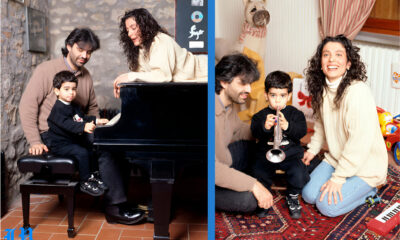Fashion
The Dirndl A Comprehensive Guide to the Iconic Traditional Dress
Published
10 months agoon
By
Bilal
The dirndl is much more than just a piece of clothing. It represents a long-standing cultural tradition that originated in the alpine regions of Germany, Austria, and Switzerland. A dirndl dress combines elegance, history, and folklore, making it a symbol of Bavarian and Alpine heritage. Today, it’s famously associated with events like Oktoberfest and regional celebrations, but it is also worn for formal occasions and sometimes even casually in certain parts of Germany and Austria.
Whether you’re looking to learn more about the dirndl outfit for an Oktoberfest visit or are simply curious about the history of this traditional garment, this comprehensive guide will walk you through everything you need to know about the dirndl, its variations, and how to choose the perfect one for you.
1. The History of the Dirndl: From Working Garment to Cultural Symbol
To understand the dirndl, we first need to take a look at its origins. Historically, the dirndl dress was worn by working-class women in the Alpine regions. It was a practical piece of clothing, designed for comfort while carrying out daily tasks in rural areas. The sturdy materials and simple design made it an ideal outfit for maids, farmhands, and other workers who needed functional and durable clothing.
The traditional dirndl consisted of a simple blouse, a bodice, a full skirt (known as the dirndl skirt), and an apron. Each part had a practical purpose. The bodice was tightly fitted, providing warmth and support, while the wide skirt allowed freedom of movement. The apron was used to protect the dress from getting dirty while working.
As the decades passed, the German dirndl evolved from a work uniform to a more refined, fashionable outfit. By the 19th century, women in cities began adopting the dirndl, and it became a fashionable statement during holidays and festivals. Today, the dirndl outfit is synonymous with regional pride and is often worn during cultural celebrations like Oktoberfest and weddings.
2. Understanding the Parts of a Dirndl: The Complete Outfit
While the dirndl dress may look like a simple garment at first glance, it is actually composed of multiple elements, each contributing to its unique charm. Let’s break down the key parts of the dirndl outfit:
The Blouse
The blouse is typically a cropped, short-sleeved or puff-sleeved garment worn underneath the bodice. Traditionally, the blouse is white, but modern variations include many different colors and styles, such as lace or off-the-shoulder designs. The neckline of the blouse plays a significant role in how the dirndl outfit looks, with higher necklines being more modest and lower ones adding a flirtier touch.
The Bodice
The bodice is the fitted part of the dirndl that accentuates the waist and bust. It is often laced up in the front or side, using hooks or eyelets. Traditionally, the bodice was made from sturdy fabric, but today, you can find bodices in a variety of materials, from cotton to luxurious silk and velvet. The bodice is one of the most crucial elements that determines the overall style and fit of the dirndl outfit.
The Dirndl Skirt
The dirndl skirt is the most iconic part of the dirndl dress. It is typically a full, knee-length or calf-length skirt, though there are also modern, mini-skirt versions of the dirndl. Traditionally, the dirndl skirt reaches just below the knee, allowing for easy movement and a flattering silhouette. Longer skirts are associated with more formal or traditional occasions, while shorter skirts have become increasingly popular for casual settings and events like Oktoberfest.
The Apron
The apron is tied around the waist and adds a practical yet decorative element to the dirndl outfit. In traditional settings, the apron was used to protect the skirt while working, but today, it serves more of an aesthetic function. The apron can be tied in various ways, and its position can convey different messages. Tying the apron knot on the right side indicates that the wearer is married or in a relationship, while a knot on the left signifies that the person is single. Tying it in the middle traditionally means the wearer is a virgin or pure, and tying it in the back can signal widowhood.
3. The Modern Dirndl: Fashion Meets Tradition
Though the dirndl has deep roots in tradition, it has also adapted to modern times, especially with the rise of Oktoberfest. The Oktoberfest dirndl has become a popular choice for festival-goers looking to embrace Bavarian culture while also adding their own personal style.
Traditional vs. Modern Dirndl
The traditional dirndl typically has a modest design, with conservative necklines and longer skirts. These dirndls are made from high-quality materials like wool, silk, or cotton, and the colors are often earthy tones or simple, solid shades.
On the other hand, the modern dirndl offers more flexibility. You’ll find bolder colors, shorter skirts, and a variety of blouse styles, such as lace or off-the-shoulder designs. While many people still prefer the elegance of a traditional dirndl, the Oktoberfest dirndl is often a fun, more relaxed version of the outfit, perfect for enjoying the festive atmosphere.
Dirndl Dress Styles for Oktoberfest
For those heading to Oktoberfest, choosing the perfect dirndl dress is key to having a great time. The best Oktoberfest dirndl blends tradition with your personal style, so it’s important to consider the length of the skirt, the color of the apron, and the overall vibe you want to project. Some popular dirndl styles for Oktoberfest include:
- Flirty Mini Dirndl: With a shorter skirt, this style is playful and perfect for partying.
- Vintage Dirndl: Featuring lace and elegant fabrics, this option is more traditional and formal.
- Bavarian-Style Dirndl: Designed to mirror the regional styles of Bavaria, this dirndl usually has a classic fit, earthy colors, and a longer skirt.
4. Dirndl Accessories: Completing the Perfect Outfit
No dirndl outfit is complete without the right accessories. Whether you’re going for a traditional dirndl look or something more modern, the following items can help you complete your ensemble:
Shoes
Traditionally, dirndls are paired with simple leather or suede shoes, such as ballet flats or low heels. However, many women opt for trendy boots or high-heeled shoes for a modern twist. For Oktoberfest, comfort is key, so be sure to choose shoes you can walk in for long hours.
Jewelry
Traditional jewelry, such as chokers, delicate chains, and brooches, can add a beautiful touch to your dirndl. Opt for pieces with floral motifs or even family heirlooms to enhance your look.
Tights or Stockings
In cooler weather, women often pair their dirndl dress with tights or patterned stockings. This adds both warmth and elegance to the outfit.
Handbags
Small handbags or clutches are ideal for keeping essentials like your phone and money. For a more authentic look, consider a traditional-style bag with embroidery or a leather design.
5. How to Choose the Right Dirndl for Your Body Type
Choosing the perfect dirndl dress can be a challenge, but it’s all about finding the right fit for your body type. Here are some quick tips for selecting the best dirndl outfit:
- Petite Figures: A dirndl with a knee-length or shorter dirndl skirt can help elongate your frame. Look for styles with detailed bodices or lace to draw attention upward.
- Curvy Figures: Opt for a dirndl with a more structured bodice to provide extra support and accentuate your waist. A flowing dirndl skirt can flatter your curves while adding a sense of movement.
- Tall Figures: A longer dirndl skirt that hits below the knee or mid-calf can look especially elegant on taller women. Bold colors and patterns can also work well on taller frames.
The key to finding the perfect dirndl is ensuring the bodice fits snugly and comfortably. The rest of the dress should feel easy to move in, whether you’re dancing at Oktoberfest or simply attending a traditional event.
6. Caring for Your Dirndl: Tips for Longevity
A dirndl dress is often made from high-quality fabrics, which means it requires some special care to keep it looking its best. Here’s how you can maintain your dirndl outfit:
- Cleaning: Always check the care label before washing your dirndl. Many dirndl dresses are made from delicate fabrics and should be hand-washed or dry-cleaned.
- Storing: Store your dirndl skirt and dress in a garment bag to protect it from dust and moths. If possible, hang the dress to maintain its shape.
- Ironing: If your dirndl becomes wrinkled, iron it on a low setting, especially if it’s made from silk or lace. Be cautious with high temperatures, as they can damage the fabric.
Taking good care of your dirndl ensures it will last for many years and continue to look as beautiful as the day you bought i
Conclusion
The dirndl is a timeless garment that beautifully blends tradition and fashion. Whether you’re preparing for Oktoberfest, attending a formal event, or simply interested in the cultural significance of this iconic dress, the dirndl dress offers endless possibilities for style and expression. From the dirndl skirt to the apron, each element has its own charm and meaning. By choosing the right fit, style, and accessories, you can create a stunning look that celebrates heritage while embracing modern trends.

Who Is Mason Reese? All About the American Former Child Actor’s

Who Is Lynn Hamilton? Celebrating the Life and Legacy of the American Actress

Who is Mickey Gooch Jr? The Dynamic Journey of a Film Producer and Actor

Who Is Pierre Bouvier? All About the Canadian Singer and Musician Behind Simple Plan

Who Is Pearl Minnie Anderson? Rising Star in Maya Rudolph’s Legacy

Who is Minnie Pearl? The American Comedian Who Brought Country Humor to the Spotlight

Who Is Kavan Smith? The Canadian Actor Known for His Versatile Roles

Who is Olivia Rose Cameron: The Creative Artist & Daughter of Kirk Cameron

Who Is Markella Kavenagh? All About the Australian Actress and Rising Star

Who is Tracey Hinds? Exploring the Life of Macy Gray’s Ex-Husband and Mortgage Broker

Who Is Dan Jeannotte? All About the Canadian Actor’s Career and Roles

Who Is Merri Kelly Hannity? All About Sean Hannity’s Daughter

Who Is Diana Espinoza Aguilar? The Story of Rafael Caro Quintero’s Wife

Who Is James Lesure? All About the American Film and Television Actor

Who is Eric Weinberger? A Visionary Television Producer Shaping Sports Media

Who is Charlee Fraser? The Rise of the Australian Model and Actress Making Global Waves

Who Is Toru Ohtani? All About Shohei Ohtani’s Father & Baseball Coach

Who Is Avantika Vandanapu? Rising American Actress & Singer

Who is Torrei Hart? The Multitalented Actress and Comedian Making Waves

Who is Tracey Hinds? Exploring the Life of Macy Gray’s Ex-Husband and Mortgage Broker

Who Is Mason Reese? All About the American Former Child Actor’s

Who Is Lynn Hamilton? Celebrating the Life and Legacy of the American Actress

Who is Mickey Gooch Jr? The Dynamic Journey of a Film Producer and Actor

Who Is Pierre Bouvier? All About the Canadian Singer and Musician Behind Simple Plan

Who Is Pearl Minnie Anderson? Rising Star in Maya Rudolph’s Legacy

Who is Minnie Pearl? The American Comedian Who Brought Country Humor to the Spotlight

Who Is Kavan Smith? The Canadian Actor Known for His Versatile Roles

Who is Olivia Rose Cameron: The Creative Artist & Daughter of Kirk Cameron

Who Is Markella Kavenagh? All About the Australian Actress and Rising Star

Who is Tracey Hinds? Exploring the Life of Macy Gray’s Ex-Husband and Mortgage Broker
Trending
-

 Celebrity12 months ago
Celebrity12 months agoNecati Arabacı: Net Worth, Biography, and More
-

 Celebrity1 year ago
Celebrity1 year agoDiscovering Lily Phillips: An Insight into Her Life and Career
-

 Celebrity11 months ago
Celebrity11 months agoEnrica Cenzatti: Life of Andrea Bocelli’s Ex-Wife
-

 Celebrity12 months ago
Celebrity12 months agoParker Schnabel’s Girlfriend: A Comprehensive Look at His Relationships Over the Years
